
What’s not to love about Thailand? It’s a stunning country, with beautiful people, and world-class food.
But like most travellers to Thailand, I’d never even tried to learn to speak Thai… until now!
In August 2016, I packed my suitcase and flew to Bangkok, with one mission: to (finally) learn to speak Thai.
While in Thailand, I documented my progress and adventures in daily videos on my YouTube channel.
In this post, I’m going to take a step back and reveal everything I discovered about how to study Thai as a beginner, so you can benefit from my experiments and start your journey to learn Thai on the right foot.
Table Of Contents
Here’s what we’ll cover. If you want to skip ahead, just click the section that interests you.
I’ll start by describing in detail how I learnt Thai during my mission to Bangkok. Next, I’ll answer common questions about learning Thai. Then, I’ll finish with my recommended action steps for those who want to learn to speak Thai, followed by some great resources.
- How I Learnt Beginner’s Thai in 14 Days
- Why Should I Learn Thai?
- Is Thai a Hard Language to Learn?
- Tones and Pronunciation in Thai
- Do I Need to Learn to Read and Write in Thai?
- 6 Steps to Learn to Speak Thai as a Beginner
- Recommended Resources, Teachers and Schools
I’ve also prepared an amazing PDF bonus to accompany this post:
- 150+ Essential Beginner Thai Words & Phrases for Effective Conversations (PDF & MP3 audio). Hand-picked from all my lessons and conversations in Thailand!
Learn these right at the beginning to get a huge head start speaking conversational Thai.
It’s a completely free resource; simply click here to grab your copy.

How I Learnt To Speak Beginner’s Thai
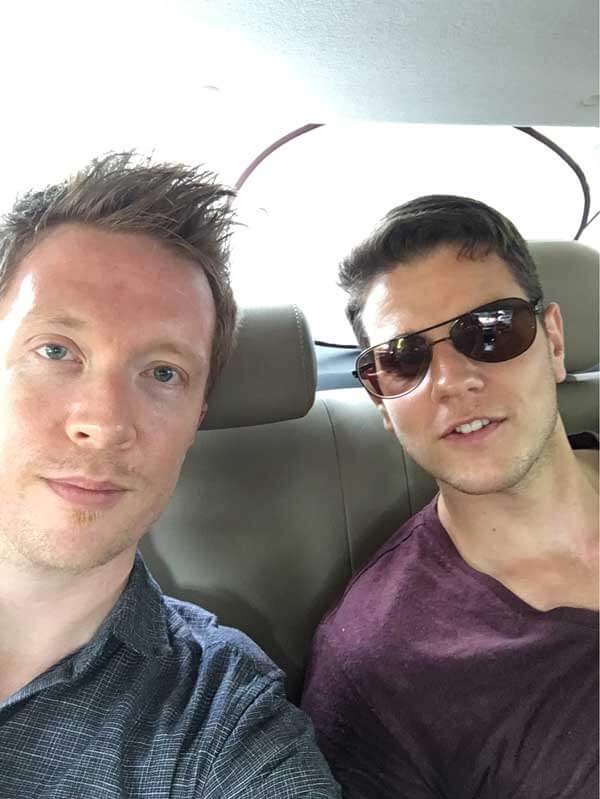
I had decided to travel to Bangkok and devote two weeks to learning Thai with my good friend Jan van der Aa. We discussed the plan in this video.
Although two weeks is a short time, it was the time I had available for travel.
I had always been curious just how much of a new language it was possible to learn in a short period.
More importantly, many other people who struggle to find the time to learn a new language might find a two-week period realistic in order to travel and learn.
So I thought I’d set an example for people in that position, and see what was possible.
As a language learner, I’m used to studying independently. In fact, my whole website is devoted to that.
However, I was up for trying something different, so I decided to do what most people would when learning a new language: I enrolled in a school, knowing I would have to submit to the study programme decided by a teacher.
There was another consideration… I didn’t trust myself to study solo in Thailand! 🙂
It would have been far too easy not to stick to the plan, and the chances of me sticking to a regime of study would not be good. (If you’ve ever been to Thailand, you’ll know why that is!)
Perhaps my eagerness to enrol in a school this time was a tacit admission that I wasn’t going to take Thai too seriously…
Maybe I didn’t have the mental strength for the commitment at that point in time…
Maybe I was looking for an excuse if I didn’t get the results I wanted…
Either way, it’s what I did.
The Thai Language School
I decided I wanted to study for two hours a day, in the morning.
It felt the right balance between taking it seriously and not torpedoing my “leisure time” completely.
Many people asked me how I chose the school – Sumaa Language Institute.
In fact, it was a recommendation from Twitter I received after tweeting that I was going to Thailand. I checked out the school and liked what I saw.
They were responsive and accommodating to what I wanted, which is always a good sign. I also heard that they were used by embassies for their language training, and that’s good enough for me. I booked right away – I’m like that.
To be totally honest, when I booked, I didn’t actually know if it was a group class or private lessons! It turned out to be one-to-one tutoring.
The cost was THB 10,000 for 20 hours tuition (roughly 220 GBP, 290 USD), which averaged at THB 500/hr (11 GBP, 15 USD/hr).
Compared to taking private lessons in the UK (at a good school), this is extremely good value. It is also broadly similar to taking Thai lessons online with iTalki.
The lessons took place in the school itself, meaning I had to travel to and from there every morning. This can be either a positive or negative depending on your disposition!
For me, it worked out well because I was craving the routine. It got me up and out of the house – although there were a few bleary-eyed mornings to be sure!
Here’s my reaction on Day 1:

The Thai Teacher
For the student, any classroom experience is always going to be down to one thing – the teacher. Teachers come in all shapes and sizes, styles and personalities, and even the best teacher will not be a good fit for every student.
I’ll just come out and say it: I struck gold.
My teacher, Kru Nuu, was one of the best teachers I have ever met (and I’ve met a lot – I used to train teachers for a living).
Perhaps I should say that she was one of the best teachers for me. I’m pretty sure I’m not an easy student to teach – I’ve got my own ideas about learning, have limited patience, and don’t do well at hiding my displeasure.
My biggest fear about joining a language school was that I would be forced to go trawl through a fixed curriculum, have limited speaking time, and learn at the speed of the slowest student in the class. As it happened, the opposite was true.
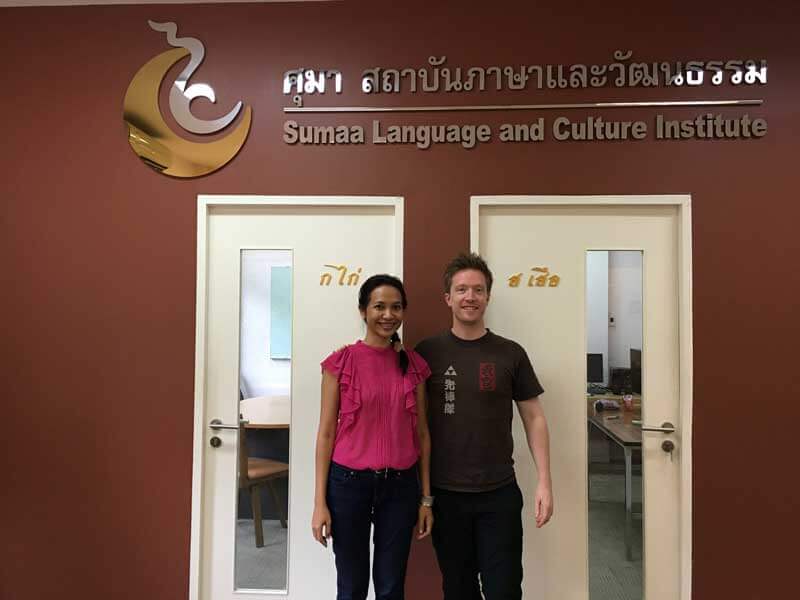
The Thai Lessons
It’s hard to sum up 20 hours of lessons in a couple of paragraphs, but I’ll do my best to draw out the main points about how we studied, so you have an idea about what happened.
- The first week involved mostly input. I learnt a tonne of stuff every day, and in the evening I would go home, practise it, and commit it to memory. This meant that on the next day we were able to move on to new things.
- By the start of the second week, I began to feel that I “knew enough,” and what I really needed to do was to consolidate everything I’d learnt in the first week. To put it another way, I wanted to leave Thailand being able to confidently use the basics rather than simply pile on new stuff for the sake of it, and not know any of it well. Therefore, the second week was devoted mostly to practice.
- We focused only on spoken Thai and did not learn to read or write.
Typically, the teacher would come to the lesson with a plan for “input” – things she would teach (introductions, greetings etc). Sometimes we would do what she prepared, other times not.
To be honest, the prepared content of the lessons were somewhat incidental to the learning.
Although we often followed the general topics she had in mind (fairly predictable for beginners), the lessons usually went something like this:
- She would ask some simple questions (usually related to what we’d learnt the day before)
- I would try to answer, and eventually get stuck
- She would teach me what I needed to get unstuck
- We would maintain the conversation (often for up to 1 hour) repeating the above steps
This is what has been labelled an emergent approach to language teaching. That is, you teach language as the need emerges from conversation.
The focus is on communication over accuracy, not the more traditional approach of accuracy over communication.
The reason this worked so well was that, after only a few days, I had already identified all the key words and phrases I needed to be able to talk about basic personal things – my life, interests, why I was in Thailand – and had plenty of practice in actually using them.
(I give you this complete list in the free bonus accompanying this post.)
This differs significantly from a traditional language classroom where you’re systematically taught a predefined syllabus of words, phrases, grammar, etc, and any speaking practice is based on that, rather than your actual communicative needs as an individual.
This is why, by the fourth day, I was already able to hold a basic conversation in Thai:
A few other important observations:
- We paid a lot of attention to pronunciation and tones from the beginning. While vocabulary and grammar mistakes were tolerated, pronunciation and tones were always corrected on the spot.
- I have a bad habit of writing down every new word in my notebook, which quickly gets out of control. The teacher was very good at carefully selecting important words and phrases from the conversations and writing them on the board, or on index cards.
- The teacher consistently prompted me to ask her questions. This was extremely helpful, as it’s often difficult for beginners to take the initiative and ask questions. It helped me to be proactive in using my Thai from the start.
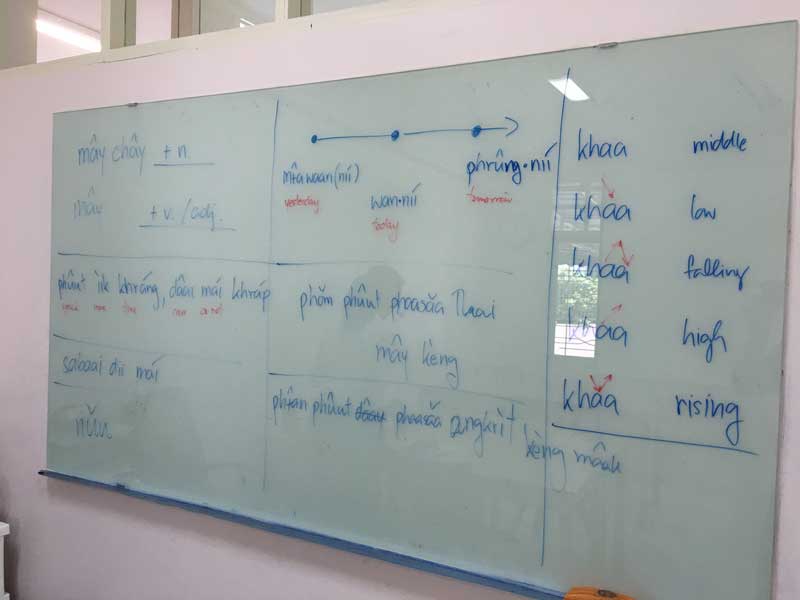
Over the course of the first week, the teacher kept feeding in new things she’d prepared in addition to the emergent language.
How My Thai Learning Changed In Week 2
However by the start of the second week, my mind had already begun to shift towards the fact that I was running out of time.
I had a dilemma: “Do I keep trying to learn as much new stuff as possible? Or do I consolidate and practise what I’ve already learnt?”
I chose the latter.
So, for the second week, we focused on practising everything from the week before. There were still plenty of new things, but they were purely emergent, and our focus was on practice.
Some things we did in Week 2:
- On two of the days, for the first hour of the lesson, Kru Nuu brought a second teacher into the lesson for me to practise speaking with. This was great, as I had become very accustomed to speaking with my usual teacher, so this was a way to help build up strength in Thai.
- On two other days, we took things out of the classroom. We went walking around the neighbourhood, chatting in Thai while we walked – no notes, no whiteboard, just speaking. My teacher would set me little tasks, like buying street food or delivering things to a doctor’s surgery. This was a great move because it just helped to make everything more concrete and real.
In most language schools, these two things wouldn’t have been possible due to limited resources. Most teachers also wouldn’t have had the initiative to do this.
Again… I’m lucky.

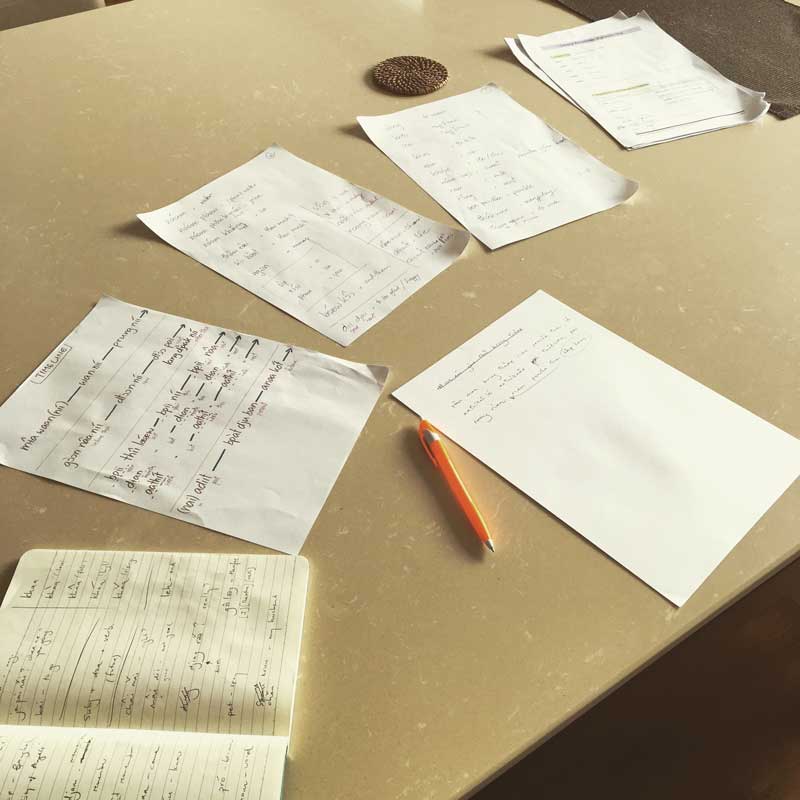
The Thai Learning Process
Due to the fact I was limited to two weeks on this challenge, I was forced to think carefully about the study process, and make sure I optimised my time.
With two hours per day in the classroom, we covered a lot of material – my notebook quickly filled up with new vocabulary, phrases, and grammar points.
When I left the classroom on the first day, I immediately realised something important; when I went back the next day I wouldn’t be able to recall 90% of what we had covered.
Let me say this another way…
Studying, learning and memorising are not the same thing.
In the course of the first lesson, I’d studied a tonne of stuff. I may or may not have learnt it, but one thing’s for sure: I hadn’t memorised it.
So how did I want to make use of the lesson time on day two…
- Memorising the stuff from day one?
- Or learning new things?
Clearly, it would be better to move on and learn new things. But in order to do that, I would have to make sure I had done my bit by memorising as much as possible from day one.
Therefore, every evening, after the lesson, I sat down and spent around an hour going over and actively memorising as much vocabulary as possible from that day – mostly single words.
I believe strongly that while a teacher can guide you, and give you lots of great language input, the learning has to occur outside the classroom, either by speaking with people, reading books, or reviewing your notes.
When studying foreign languages, real learning has to occur outside the classroom.
I don’t have space to go into memory techniques here, but if you’d like to know more about learning and memorising vocabulary, be sure to sign up to my mailing list for detailed explanations and training.
If I had to do it again, one thing that would have helped me a lot is Vocabooster Thai, because it comes with all the most important Thai words and phrases pre-loaded into flashcard decks… huge timesaver!
After the first week, I had the feeling that I was acquiring a lot of vocabulary, but what I really needed was an understanding of how it all fit together.
This is partly a lack of Thai grammar comprehension, but more importantly, and a more common problem, that I really hadn’t spent any time listening to Thai. I had a very weak foundation.
Therefore, my study focus out of class began to shift in week two, away from learning single words, and towards learning complete sentences, so that I could actually start to use the language out in the real world…
After eight days of lessons (16 hours), I recorded this video of me speaking Thai with my teacher.
Why Should I Learn To Speak Thai?
There are many possible reasons why you might want to learn Thai:
- You live in Thailand
- You’re planning to visit Thailand
- Your significant other is Thai
- You’re fascinated by Thai culture
Whatever your reason, you should be encouraged!
Why?
Because relatively few foreigners ever go to the trouble to learn Thai. By learning even the basics of Thai, you will immediately endear yourself to the locals, gain their respect and admiration, and transform your experience of Thailand and Thai people.
What’s more, learning Thai is probably not as hard as you think…
Granted, it’s different from English – it certainly sounds different!
But as you’ll discover in this post, despite the differences, there are plenty of aspects of Thai which are far simpler than in other languages.
This means that with a bit of time and effort spent in the right areas, you can quickly start speaking the language and enjoying the benefits!
Whatever Thailand means to you and your life, you’re in for a treat!
Is Thai A Hard Language To Learn?

Whether a particular language is difficult or not, is always a tricky question to answer.
What constitutes a difficult language is not the same for a native English speaker as for a native Chinese speaker.
It’s been interesting for me to learn Thai, as I’ve been able to observe similarities with various other languages I know.
In particular, my knowledge of Cantonese (a dialect of Chinese) has proven to be extremely useful, in terms of shared vocabulary, tones, and grammatical points of reference. (I’ve been told I have a Chinese accent when I speak Thai, which is revealing!)
I’ve also found some vocabulary that seems to be in common with Arabic and Japanese – two languages unrelated to Thai.
So, given my existing knowledge of Asian languages, it may be difficult for me to be completely objective on assessing the difficulty of Thai. But let me say this…
While mastering Thai is a lifetime’s work, the basics of Thai are straightforward enough that you can very quickly pick up a working knowledge of the language and start using it in conversation.
Plenty of things make Thai straightforward for beginners, especially when compared to some European languages, for example:
- Verbs are not conjugated.
- Nouns do not have plural forms or gender (although you do need to learn classifiers)
- Tenses (present continuous, past, etc) are indicated with simple “time words”, rather than complex verb forms (see here for an interesting discussion of this).
- Words in Thai tend to be shorter than in e.g. European languages.
(There are a number of features of the Thai language which are generally ignored in English, such as marking social status, or maintaining the correct register. However, as a beginner, you can put these off till later!)
As a beginner, you’re likely to find two things to be daunting about Thai:
- Thai letters, in other words Thai script
- The “sound world” – for want of a better term – Thai tones, pronunciation and intonation (covered in the next section)
Many people who learn a new language misinterpret unfamiliarity with difficulty, leading them to make statements like: “Thai just isn't for me,” or “I’m just not good at languages.”
Your first impressions of Thai will surely be that it’s a very different language. But although it may be unfamiliar, it doesn’t mean it’s objectively hard.
You simply need to approach it with the mindset of, “I’m going to give myself time to become familiar with it,” and keep it up for long enough that the unfamiliar becomes familiar – then you’ll wonder what all the fuss was about!
When in Thailand, I heard many stories of expats who were initially very keen to learn, and even enrolled in classes, but gave up before they really gave it time to sink it.
In order to mitigate this specific danger, I’ll be recommending that, as a beginner, you commit to an initial 20 hours of study with a teacher, before allowing yourself the indulgence of getting frustrated. 🙂

Tones And Pronunciation In Thai
If you’ve ever heard Thai being spoken, you’ll have quickly realised it doesn’t sound like English!
One of the reasons it sounds so different to our ears is because Thai is a tonal language: “A language in which the same series of sounds can represent different meanings, depending on how high or low they are spoken.”
There are five distinct tones, which can be represented visually like this:
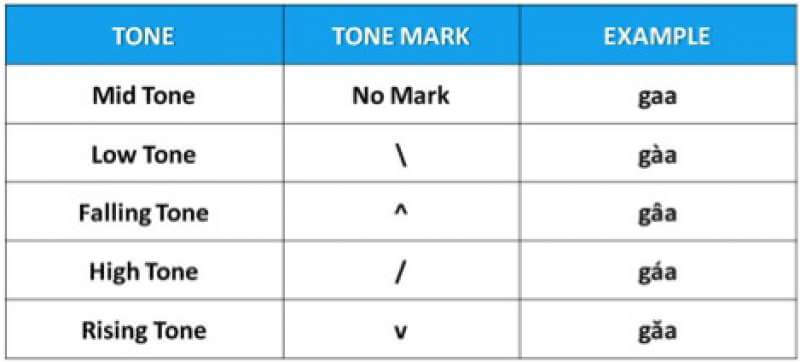
Tonal languages often scare people wanting to learn them.
“Hey – check this out! If you say maa like this it means mother, but if you say it like this it means horse! Be careful!”
This is usually followed by: “I could never learn that! I can’t even spell in English!”
Listen: It’s not as hard as it seems. Honestly.
You’ve done plenty of other “difficult” tasks with languages…you learnt:
- whether nouns in French are masculine or feminine
- to roll your Rrr in Spanish
- how to pronounce “ough” in 6 different ways: thought, through, though, cough, plough, enough…
The thing about tones is that they’re just less familiar. With each new word you encounter, you simply learn the tone that comes with it.
After an initial period of adjustment, learning the tone of words in Thai quickly becomes second nature. You hear the most common conversational words over and over again, and that makes it easy to learn to speak Thai and become familiar with the tones.
What If I Already Speak A Tonal Language?
I’ve noticed many people who already speak a tonal language (like Mandarin Chinese) say: “I’m scared to learn Thai, because I’m worried it will interfere with my Chinese!”
Far from being a risk, I personally found it a huge advantage to already know a tonal language – Cantonese in my case – for the following reasons:
- I was comfortable with having to learn tones along with vocabulary
- My ear was already used to listening for tones, so I had a natural mechanism for picking up and remembering them
- My experience of speaking with 6 tones in Cantonese made it much easier to produce tones in Thai
Given that learning tones is mostly a question of familiarity, already having a tonal language under my belt was a huge leg-up.
Will learning Thai interfere with a tonal language you already know? Yes, possibly. For me, this falls into the larger question of how to maintain multiple languages.
Warning About Thai Tones And Thai Script
Because you can't read Thai yet as a beginner, the only way to remember the tone for each word is with a little line, often called a tone marker (check out the diagram above).
It’s important to remember, however, that this visual representation is not accurate – it’s just an approximation of the true tone (which are flexible, and can adapt anyway).
The true tones can actually be found embedded in the Thai script itself, which is an important reason to learn the script (we’ll discuss this later):
My view at the moment is this:
- If you plan to learn Thai seriously, you should get away from the romanised script as quickly as possible, and learn the Thai script (see next section). However, this takes time.
- As newbie, romanised tone markers are a very helpful “way in,” and help you get over that initial hump.
- I believe there’s huge value in momentum and progress in a new language, especially as a beginner, so it’s ok to use tone markers with the romanised script as a guide for the first few weeks.
- Just be aware you’re not getting the full picture, and make sure you work with a teacher to help you with tones from the start.
Thai Pronunciation
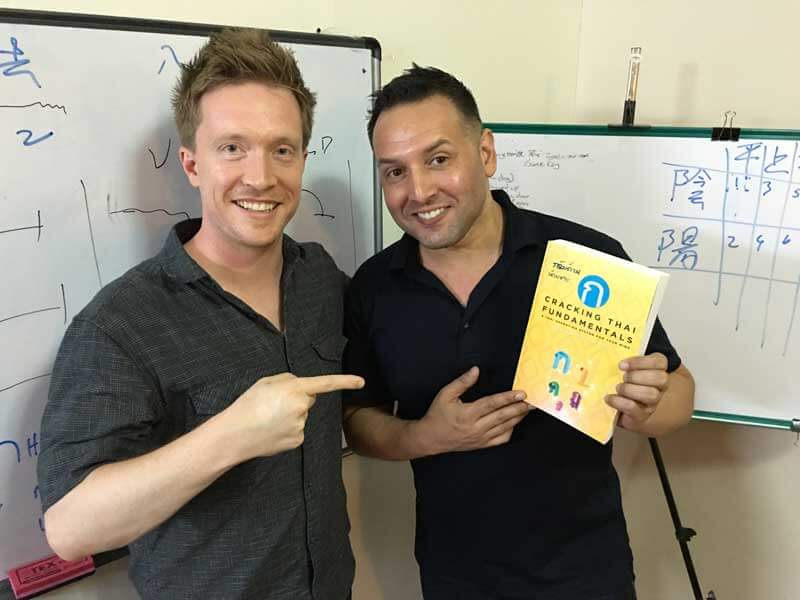
Pronunciation is a general term that shouldn’t really be separated from tones. But for the sake of simplicity, I’ll deal with them separately here.
There are a number of consonants and vowels that are unfamiliar to native English speakers and need to be learnt.
I found that many of these “unfamiliar” sounds do actually exist in English, but are not consciously learnt as standard phonics. Therefore, learning correct Thai pronunciation seems to me to be a process of:
- Becoming aware of the sounds in question.
- Noticing them being used by native speakers and being able to tell them apart.
- Consciously and deliberately practising them yourself.
For example, see if you can hear the difference between the pronunciation of the “t” in the following English words (place your hand in front of your mouth, say the words aloud, and notice the aspiration or lack of!):
- time
- stop
or
- point
- spit
If you can sense the difference between these different allophones, you’ll be fine with Thai!
Other elements of Thai pronunciation I found myself getting to grips with over the course of the two weeks I studied included:
- Long and short vowels. For example: “a” vs “aa”. There’s rarely a distinction in English, but it’s important in Thai.
- Final consonants. Consonants at the end of words are usually not pronounced in Thai. However, they’re not omitted altogether. You need to form the shape of the final consonant in your mouth and stop just short of actually producing it.
While in Bangkok, I was lucky enough to be treated to a private masterclass by famous polyglot Stu Jay Raj, in which he dissected my Thai pronunciation and demonstrated how not to learn to speak Thai without sounding like a typical foreigner.
In practice, when speaking with people, you’ll find that you can get much of the unfamiliar pronunciation wrong and still be understood (I observed no end of this among expats I met in Bangkok speaking Thai), so you shouldn’t let it put you off.
However, pronunciation is one of the hardest things to “unlearn” at a later date, so better to get it right from the start.
Do I Need To Learn To Read And Write In Thai?
First of all, I should say that I haven’t learnt to read and write Thai yet!
However, I have spent considerable time discussing the question of learning the Thai script with teachers and other experts, so I will relay what I’ve learnt here.
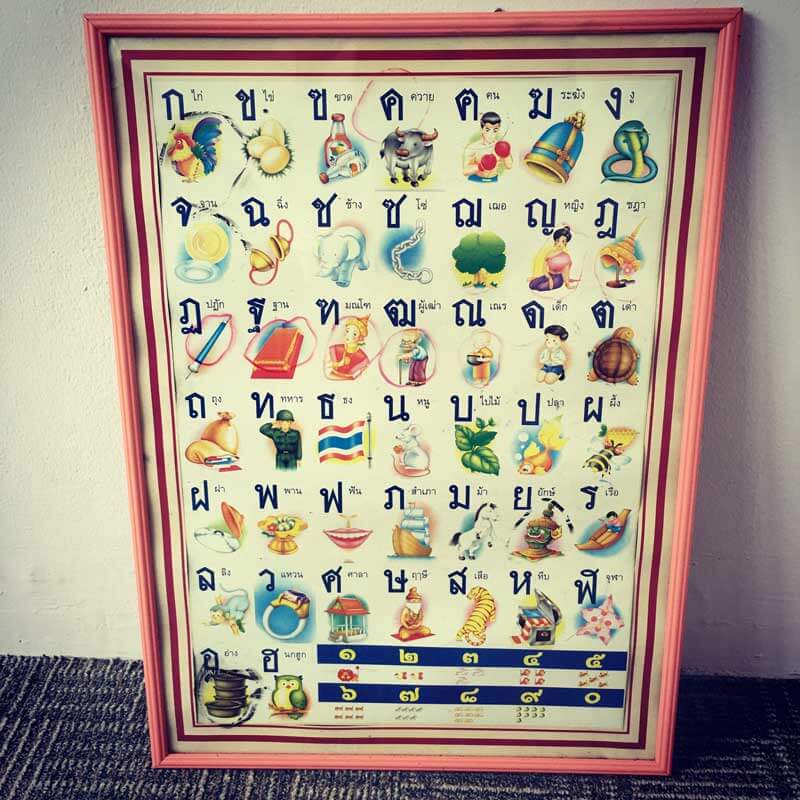
With 44 consonants and 28+ vowel forms, learning to read Thai is:
- A larger task than Arabic.
- Comparable to learning Japanese hiragana and,
- Nothing compared to the challenge of learning Chinese!
Whether you should learn the Thai script depends on your circumstances and goals. In my two-week project, for example, I decided not to learn, because I felt the time was better spent on conversation.
My current thoughts are as follows:
- It is possible to learn Thai without learning to read and write.
- You can use the romanised script instead (this is common practice in language schools).
- If you’re just learning “travel Thai,” and have limited study time, you can do without the Thai script.
However, the fundamental problem with using the romanised script is that it’s inaccurate:
- True tones are not as marked (see above).
- There is no standard “spelling” – everyone uses something different.
- Important features of pronunciation such as long vowels often not marked (e.g. pasa Thai ≈ paasăa Thai).

When You Should Learn Thai Script
In the long term, not learning the script will seriously hamper your progress, as you’re dealing with approximations of what people are actually saying, and are developing an incomplete understanding of the Thai language.
Therefore, if you have any ambitions to learn Thai properly, or to get beyond basic beginner’s “holiday Thai,” then you need to learn the script.
After all, there are plenty of good reasons to learn to read…
- You can read anything – menus, signs, and plenty of other useful stuff.
- You can communicate with new friends in Thai via text or instant messaging (this is one of my favourite things to do, and a great way to get over a fear of speaking).
- Use Facebook and other social media in Thai.
But above all, it will be a huge motivator and source of pride when you can read and write in such a beautiful script!
If you’re in Thailand you can buy children’s writing practice books for next to nothing. These have the letters dotted out so you can patiently fill up page after page with your embarrassingly awful handwriting!
Overall, I would probably recommend delaying learning to read and write for at least the first 20 hours, in order to focus on speaking.
There’s an inevitable opportunity cost to everything you do, and bearing in mind many people give up at the fist hurdle in a new language, I think you’ve got more to gain by concentrating on speaking – using the romanised script to help you.
(In the curriculum my teacher uses at Sumaa, you do 60 hours of conversational Thai before you start learning the script.)
Whatever happens though, don’t let fear of the script prevent you learning Thai, just be aware you’re only learning superficially without it.
6 Steps To Learn To Speak Thai As A Beginner

If you’re wondering how to learn beginner’s Thai from scratch, here’s exactly what I would recommend you do.
- Find a good teacher. This is your non-negotiable first-step. It can be a private teacher or school, face-to-face or online, private or group lessons – it doesn’t matter. Thai is a language you can start speaking from the beginning. With the right support and encouragement from a good teacher, this can be a relatively quick process. Start with 20 hours of tuition. (Recommended teachers below.)
- Study Thai fundamentals. With your lessons focusing on speaking, I would accompany them with a thorough study of Thai fundamentals – particularly pronunciation and tones. There is no-one better than Stu Jay Raj for this, and he has an incredible, interactive online course – Cracking Thai Fundamentals – available as a book or a course – that gives you the best possible grounding in the basics of Thai.
- Memorise key phrases. Whatever you learn from your teacher, there are certain key words and phrases that will give you a huge head start in conversational Thai. I’ve collected the most useful vocabulary I learnt during my lessons, and put it into a free PDF & audio bonus for you. Download it here.
- Learn to read. Most people report you can learn to read Thai on your own within a few weeks. After your 20 hours of lessons with a teacher, get a good book on reading Thai and work through it systematically. (Recommended books below.)
- Get a good Thai textbook. After 20 hours of lessons with a teacher, you’re going to start needing lots of input via reading and listening in order to move beyond beginners Thai and grow your vocabulary. Look for a textbook that contains plenty of dialogues. Here’s a list of recommended books to learn Thai. If possible, check them out in a bookshop before you buy, and choose one you like the look and feel of.
- Find Thai people to speak with. One endearing thing about Thai people is that they love it when foreigners learn their language. Whereas in some languages native speakers will make life difficult for you when you try to practise with them, Thais will gladly play along. Knowing this means you can get a lot of useful, real-life practice that will help you acquire the language faster than otherwise. If you live in Thailand, search online for language meet-up events or look for conversation partners on sites like conversationexchange.com (face to face language exchanges tend to be more serious and enduring). Outside Thailand, you might need to dig a little deeper. Google ‘Thai language exchange,’ ‘Thai society,’ etc. and you’ll find something eventually.
As you progress, you should also listen to the I Will Teach You A Language podcast, to help you stay motivated and become a better language learner.
Jump back to the contents!
Recommended Resources For Learning Thai
Thai Courses
- Cracking the Thai Fundamentals – A world-class book and online course from Stu Jay Raj to help you understand and nail the fundamentals of Thai from the beginning.
- Vocabooster Thai – A resource that Jan himself has created after our trip to Thailand! It teaches you the key words and phrases you need to start speaking and communicating in Thai from the beginning. Highly recommended.
Thai Language Schools
Top Recommendation:
- Summa Language and Culture Institute, Language School in Bangkok. This is where I studied, and had an incredible experience from start to finish. If you can study here, do it.
Other schools that have been recommended (although I can’t personally vouch for them):
In Chiang Mai:
Online Thai Language Teachers
- Kru Jan from Chiang Mai also teaches on Skype.
- iTalki is my favourite website for finding language teachers online.
How To learn To Read Thai
The following books and courses to learn to read Thai have come highly recommended. I’ll update this list in due course once I’ve learnt to read myself!
Thai Textbooks
Having not studied with a textbook myself, I can’t give any personal recommendations. However, the following books come recommended:
Learn Thai Online
- ThaiPod101 (get a premium subscription for “clickable dialogues”)
I hope you’ve found this post useful!
Learning Thai, although for a short time, was a fantastic experience, and I was super happy to be able to speak with Thai people in their own language.
If you have a friend learning Thai, please take a moment to share this post with them, or on social media – it would mean a lot to me! (You can click here to send a Tweet!)
I’d like to thank Catherine Wentworth from Women Learn Thai for huge amounts of help and advice, both during my trip to Thailand and in subsequently putting together this article.
I’ve prepared an amazing FREE bonus guide for you to accompany this post. I’ve handpicked the 150 Thai words and phrases that helped me start to speak Thai right at the beginning, and including mp3 audio of each one. If you’re learning Thai, you should start with these! Simply fill out the box below for instant access.


Olly Richards
Creator of the StoryLearning® Method
Olly Richards is a renowned polyglot and language learning expert with over 15 years of experience teaching millions through his innovative StoryLearning® method. He is the creator of StoryLearning, one of the world's largest language learning blogs with 500,000+ monthly readers.
Olly has authored 30+ language learning books and courses, including the bestselling "Short Stories" series published by Teach Yourself.
When not developing new teaching methods, Richards practices what he preaches—he speaks 8 languages fluently and continues learning new ones through his own methodology.









































